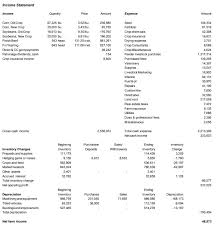This article discussed the net income statement, its components, and its significance in agricultural finance.
Income Statement or Profit and Loss Statement

An income statement is fundamentally different from a balance sheet. While a balance sheet considers assets and liabilities without accounting for operational efficiency in terms of receipts and expenses, an income statement includes receipts, expenses, gains, and losses.
It can be defined as a summary of receipts and gains minus expenses and losses over a specified period. Typically prepared for an entire farm over one agricultural year, the income statement assigns monetary values to inputs and outputs. It is also prepared over time to track trends.
The advantages of an income statement are numerous. It highlights trends in various cost items and identifies any over-expenditure on the farm. This helps in assessing the success or failure of a farm business over time. The income statement comprises three main items: receipts, expenses, and net income.
1. Receipts
Receipts refer to the returns obtained from the sale of crop produce and other supplementary products like milk, eggs, wages, and gifts. Gains from the appreciation in the value of assets are also included in receipts. However, returns from the sale of capital assets, such as livestock, machinery, and farm buildings, are excluded because such income is not generated during the operational period.
2. Expenses
Expenses include operating and fixed costs. Losses due to depreciation on asset value are also recorded under expenses. However, expenditures on the purchase of capital assets are not considered.
3. Net Income
Net income is divided into three categories: net cash income, net operating income, and net farm income.
i. Net Cash Income: This reflects cash receipts minus cash expenses during the period for which the income statement is prepared.
ii. Net Operating Income: Calculated by deducting operating expenses from gross income, this metric excludes fixed costs. Operating expenses include crop loans.
iii. Net Farm Income: This equals net operating income less fixed costs. It is a better measure of farm performance compared to net cash income and net operating income, as it represents the return on owned capital and family labor.
An income statement for a given farm in a specific year may present a favorable picture. However, this should not be taken as the farm’s actual position, as the year might have been favorable due to weather, yields, prices, etc. A realistic assessment of farm performance requires preparing income statements over multiple years to account for fluctuations in influencing parameters.
Read Also: Recommended Volume of Water for Fish Farming on a Concrete Pond
Financial Test Ratios in Agricultural Finance

The performance of a farm business, as indicated in Table 4.1, can be assessed through income analysis using two key parameters: costs and returns. However, additional insights can be gained by considering financial test ratios, which provide supplementary information. These ratios assist farmers and lending institutions in developing standard norms.
Two sets of income ratios can be developed:
1. Expenses-Income Ratios: Derived directly from the income and expenditure pattern.
2. Investment-Income Ratios: Calculated by comparing income levels against capital investment in the farm business.
Read Also: Concrete Pond Management: Steps to take before introducing the Fish in the Water
Management Ratios in Farm Business

Management ratios measure the productivity of a farm business. Unlike financial test ratios, these are derived from related information rather than the income statement. Key management ratios include management return, crop yields and value, livestock income, gross income per man, and gross income per naira investment.
1. Management Return
Management return is calculated by deducting unpaid family labor wages and interest on owned capital from net farm income. For example:
i. Net Farm Income (N) = 29,200
ii. Unpaid Family Labor Wages (N) = -5,000
iii. Interest on Owned Capital (N) = -900
iv. Management Return (N) = 23,300
A better assessment of farm performance can be made by comparing management returns over several years.
2. Crop Yields and Value
This ratio compares the yields obtained by farmers for different crops with the average yields of the area. Similarly, the value received can be compared. Data over time is essential for appraising the farm financial manager’s ability.
3. Livestock Income
Livestock income is a component of farm business income. The efficiency of livestock management can be evaluated by comparing feed expenditure against livestock income. Consistent data over time is necessary to assess the efficiency of the livestock enterprise.
4. Gross Income per Man
This ratio measures labor efficiency by considering the number of laborers employed. Factors influencing this measure include the nature of crops (e.g., cereals, fiber crops, oilseed crops) and the use of machinery. In a homogeneous area, this measure should remain stable over time.
5. Gross Income per Naira Investment
This is an input-output ratio. A progressively higher ratio over the years indicates better business performance.
Do you have any questions, suggestions, or contributions? If so, please feel free to use the comment box below to share your thoughts. We also encourage you to kindly share this information with others who might benefit from it. Since we can’t reach everyone at once, we truly appreciate your help in spreading the word. Thank you so much for your support and for sharing!
Read Also: Adaptive Means of Animals Coping with the Environment

